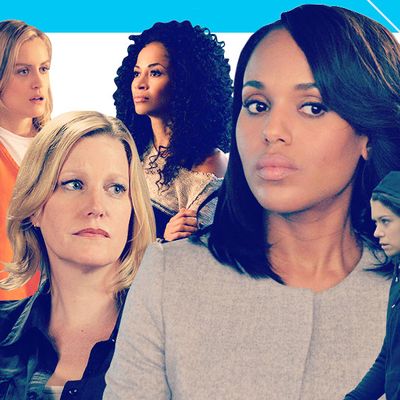
Maybe someday there will be as many roles for women as there are for men. I dream of that day. I’d especially love to watch more shows about complex, interesting female characters — and I’d be particularly overjoyed if those shows weren’t fundamentally about romance or child-rearing. (Nothing wrong with either, but that hardly represents the totality of lived female experiences. Variety is the spice of life!) I’d like to think that day is fast approaching, and this year in television gives me hope: 2013 brought us enough shows, characters, and buzz that I can look around and say “more like this, please.” There is still major, major ground to gain, and smashing the patriarchy takes a long time. But maybe we’re making some progress.
Orange Is the New Black was all anyone could talk about this summer. The show is engrossing, the performances are terrific, its stories are almost all about women — but what’s really striking about the show, and what one hopes its legacy might be, is the range of women on the series. Women of different races and ethnicities, straight and gay, femme and butch, trans, cis, young, old, poor, rich, empowered and disempowered in different ways.
Luckily, Orange was not the only show this year that was specifically female-driven. Orphan Black also will always primarily be about its female protagonist — well, all its protagonists, who slowly discover they are clones of one another. There is no white knight, nor is there the typical science dorky guy who pops in to explain everything. (One of the clones, Cosima, is plenty sciencey.) American Horror Story: Coven is so female-centric it sometimes feels revolutionary. (Bonus points for female characters of different ages, ethnicities, and intellectual capabilities.) Top of the Lake had plenty of significant male supporting characters, but that was Elisabeth Moss’s miniseries from top to bottom. (Holly Hunter had her moments, too.) Girls, obviously, is primarily stories about women, but Enlightened (R.I.P.) and Veep, too, are definitively female-driven.
Another boon this year? It’s not just the quality of shows about women, it’s that many of these shows were created by women, too. OITNB comes from Weeds’ Jenji Kohan, but easily the biggest TV story of the year is the rise of Scandal. Kerry Washington is the face of exciting network television, and Scandal surrounds her with a dazzling Lady Macbeth, a budding torture expert, and a terrorist mother — and those are just some of the women.
Elsewhere in Shondaland, Grey’s Anatomy is currently wading through the most interesting examination of feminist working-mom politics TV has ever done. Cristina Yang and her BFF Meredith Grey started out on the same path to be world-class surgeons. Along the way, though, Meredith got married and had two children; Cristina married and divorced, had an abortion and remains childless. Cristina accused Meredith of slowing down; Meredith accused Cristina of being selfish, and they fought and fought. (Cristina drew a distinction between Meredith and the show’s other working moms, like Bailey, who didn’t “let up.”) It’s emotionally rich and wholly true to the characters, but even more satisfying is knowing this is a conversation that could only happen between two female characters.
We’ve seen interesting shifts on shows that are not primarily about women, too — specifically Mad Men and Breaking Bad, two shows with deeply maligned blonde wives. In 2013, though, Betty and Skyler were cast in a new light. Betty seemed to find herself and was able to out-Don Don, sleeping with him and then happily ditching him to rejoin her (loving, devoted) husband.
Skyler’s recontextualization on Breaking Bad was a little different. Actress Anna Gunn wrote an op-ed about the Skyler haters, suggesting that misogyny was a major factor in the vitriol directed at her character. This is certainly so, but it’s not the whole picture: The truth is that in early seasons of Breaking Bad, Skyler was annoying, and she was a buzzkill, and it seemed like were were supposed to dislike her so that we might find more joy and intrigue in Walt, who is a terrible person. As the show wore on, though, the depths of Walt’s depravity became unbearable, and we as viewers couldn’t help but see things through Skyler’s eyes — of course making her not just more sympathetic but more human. By this year’s final eight episodes, Skyler became the nexus of tragedy on the series, the only person who could really say that she didn’t sign up for any of this. (Hey, Hank signed up to be a DEA agent; he knew what the risks were.) Through changes in the story and changes from the characters themselves, Betty and Skyler each gave viewers new perspectives — new female perspectives — on their stories and on the other characters.
The interracial lesbian foster moms on The Fosters; the weird sister dynamic between Tina and Louise on Bob’s Burgers; Mindy Kaling on The Mindy Project; Alicia, Diane, Kalinda, and Robyn on The Good Wife; Bullet on The Killing; Anna Farris and Allison Janney on Mom; Stephanie Beatriz’s Rosa on Brooklyn Nine-Nine; Abbie on Sleepy Hollow; everyone on Getting On — everywhere I looked this year, there were interesting women with unusual stories and unusual styles, ideas, and perspectives. I hope there are more next year, especially more stories by and about women of color, queer women, and women with a wider range of body types and physical abilities. One show, one character — that’s not enough. AMC, FX, Showtime, BBC — they all have plenty of shows with male leads, some shows with male and female leads, but a real dearth of shows that have female, and only female, leads. Hell, I’d be thrilled to see even a USA show whose episodes pass the Bechdel test.
But until then, I’ll just rewatch Orange Is the New Black.




